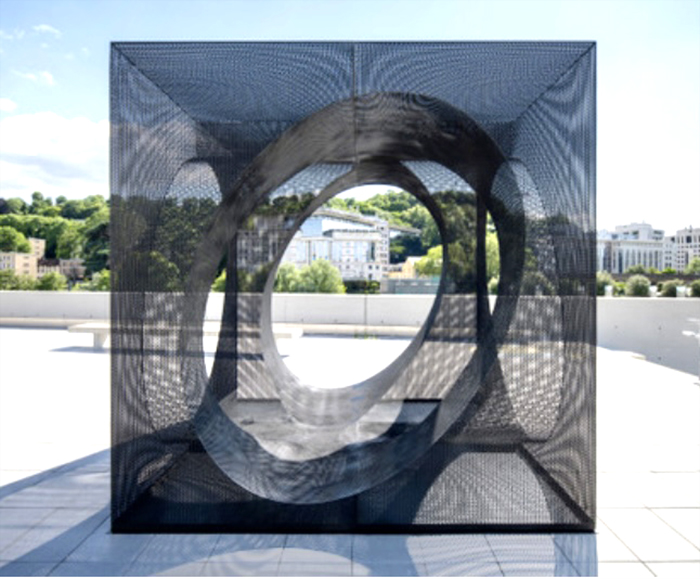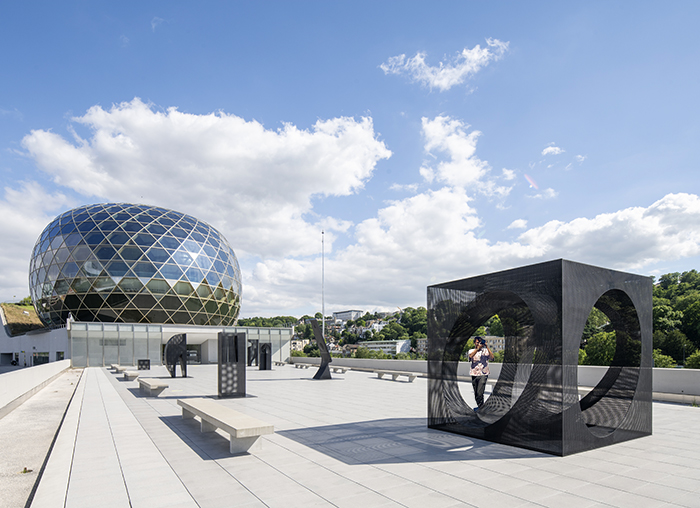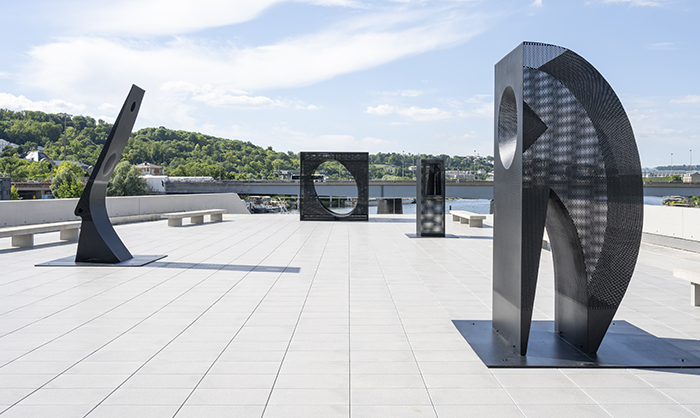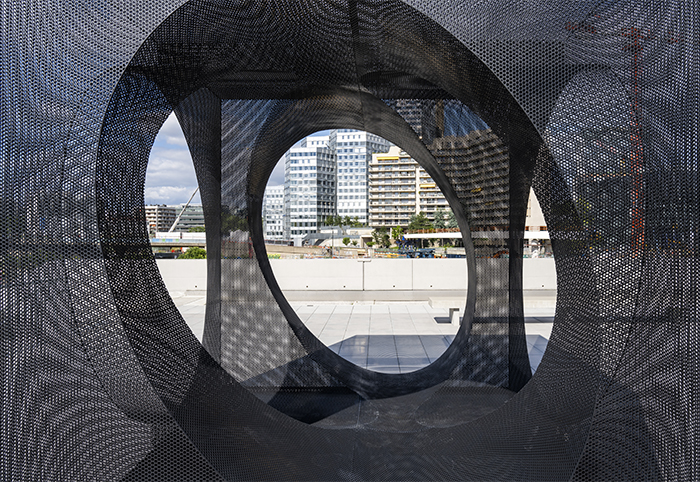LES EXTATIQUES 2021

LES EXTATIQUES 2021 : 7 sculptures de Jean-Bernard Métais sur la place Rodin / Scène musical de l’ile Seguin Boulogne Billancourt . Les Extatiques Juin 2021 au 3 octobre 2021
For so long the affirmed presence of the work in space, the effect of its mass, the quality of its deployment, the insistence of its aura, was the historical question of sculpture, what drives the research of Jean-Bernard Métais is rather to imagine objects that have the capacity to incorporate energies into the work, thus making it possible to visualize the incessant metamorphosis of things. Thus, for example, in the mirror of an immense hourglass, the back of the plan shows the sand which, moved, acts on its shape, and digs rimes there upon its depletion, a kind of counter-form, as if the disintegration of its volume revealed a pentacle of which geometry would be the spell. The gaze is then retained, fascinated by the spectacle of simultaneous transformations of the sand, which by changing the plan liquefies, builds pyramids or writes words according to a necessity carefully calculated by the artist. Of course, without the mind having to formulate it, the sand tells the time and collects the geological events, the animal and vegetal lives of which arena is only the deposit before its grains are bunched again and undertake by this concatenation a new cycle which will refute the title that the artist gives to these alloted times, since, each one of them, precisely uncloses the circle of time.
The sculptures of Jean-Bernard Métais are never separated from the world, because their question is not that of their unity closed in the silence of the stone or the bronze but on the contrary their dialogue with the open. The honeycomb metal associates its colors with the changes of the sky and the clouds. And the sculpture which can take the form of a shelter, like the Passe-muraille in Luxembourg, is only a fishnet divided into two quarters which, revealing the landscape when you seek its protection, indicating that separation would be the only threat. The body, woven by the projections of light and shadow that slide on it the movements of the sun and clouds, coordinates the human to his context as if this link was the ultimate asylum.
The link, it is, yes, that of the object to the cosmos or that of the individual to its history or to its contemporaries and, that it is fulfilled in its reflection on the water like the two-headed sculpture of Djurong in China or in the words of the population as the great obelisk of Valencienne, the work acts only because it is connected and that it can thus show the spectacle of the changes in progress, those of the spirit like those of nature. Fragile, sometimes frail as the rigging of a ship, but set to capture all the oscillations of the phenomena, these sculptures, sometimes swollen like yurts but agitated by the light and the wind, often erected like vigilantes, attentive such as the brisk antennas of an insect, these works, offered to the cosmos, available to its forces and confident in their strength observe for us and transmit the activity of the sensible world. By thus impulsing the graph of the indefatigable activity of nature, they connect us and sometimes lift us up. Thus Fort Lambert rests his secular spur on the waves of time, finding in this movement a breath that agitates like a chest inflated by the effort. He is there, he is an architecture, he will be sand, he is in the great cycle, he is alive.
Jean de Loisy
Directeur de l’Ecole Nationale des Beaux-Arts
crédit photo: Martin Argyroglo, JB Métais
News
- Sydney 2023
- Qianhai Word - Shenzhen 2020/2021
- Crossing 2020 - Pittsburgh (en cours de création)
- Place Making Bruxelles 2018-2019
- Core Nubes- Bourget Airport - 2018/2021
exposition
- exhibition
- EXPO 1/72è LandART2023 TOULOUSE
- LES EXTATIQUES 2021
- Exposition IVRESSE 2022
- THE SENSORIAL ROOM 2019/2020 Galerie La Forest Divonne
- EXPO Sensorial room - Castel of Poncé/Loir
- KOMOLEBI
- Exposition "VIVRE" Abbaye de Silvacan
- "IVRESSE" Mai juin 2017 Paris Galerie Laforest divonne
- "ESPRIT DE VIN" 2016/2017 Lilles musee des Beaux arts
- "LES TEMPS IMPARTIS" 2015 Bruxelles Galerie la forêt Divonne
China (2012-2019)
- AoYang 2018
- Sanya -2018-2019
- Red Sun - Shangra
- Wind Organ - Nanjing
- Constellation - Wuhan
- Phoenix-Oriflamme - Tianjin
- Vortex (2014). Jurong (China)
- Sensorial Room - Jurong 2142
Selected Artworks
- Expo Dubaï 2020
- Gira londa (2017) Bordeaux
- Alliance, Cardiff (Wales)
- Litany (2007) - Valenciennes (France)
- The Wave (2007) - Luxembourg
- Walking through Walls (2006) - Luxembourg
- Alloted Time-Eclipse (1999-2002)
- Fluorescence - Japon (2009-2010)
- The Halo (2002) - Paris
- An Anthropological Structure of Imaginary (2005) - Strasbourg
- Immersion, London
Archives
- Brussels exposition June 8 to July 20 - Galerie LA FOREST DIVONNE
- Invalides (2013) - Paris
- Memorial (2013)
- Create yourself... (2011). Beijing (China)
- Eu - France (2010-2011)
- Equeurdreville - France (2010)
- Parc du musée de Tessé du Mans - France (2009)
- Cap d'Agde (France) 2009
- Clepsydra (2007)
- Corolla (temporary installation)
- Sensorial Chamber (temporary installation).
- Being-Names (2004)
- Chambre d'éclipse - Donjon de Vez (2002)
- Being-Word (2000)
- The Persistent Desire to Persist (2000)
photo
Project
- Sensor dream - lysfiskeren - Bergen - Norway
- Polen - London (2011)
- The Ring (2008). London
- Jussieu (France) 2009
- Stadion (2003). Salzburg
- Screen (2007). Liverpool (UK)
- Perth (Australia) 2009
- Vancouver (Canada) 2009
Work in Sand
- Expo 2015: Temps impartis et être mot
- Boa vibrant
- Temps imparti & paysages (2000)
- Eboulis 1998
- Depossession (1994)
- les réversibles
- irreversible 2002
- Les centemps






